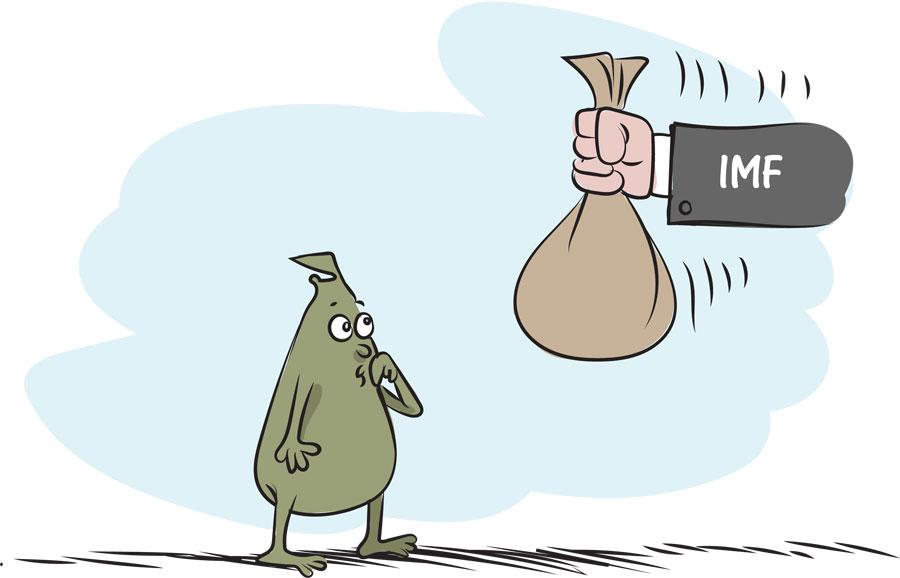Reply To:
Name - Reply Comment
Last Updated : 2024-05-17 11:24:00

A delegation from the IMF is expected to visit our country between August 24 and 31 in response to Lanka’s application for a facility from the institution.
At present we have to pay off US$3.4 billion between June and December this year, US$5.8 billion in 2023, US$4.9 billion in 2024, US$6.2 billion in 2025, US$4.0 billion in 2026 and US$4.3 billion in 2027. The majority of these debts come in the form of ‘Sovereign bond sales’ - short-term loans - which to be repaid at high interest rates in full on particular dates.
The total debt burden of the government at the end of 2021 was Rs.17.5 trillion and by March 2022 it had increased to Rs.21.6 trillion. In June 2022, our country was not able to repay even the interest on bond sales, leave aside the capital.
At the same time, the country had run out of foreign currency to pay for the import of basic essentials ranging from food, to fuel, to medicines, to LP gas and fertilizers needed by the agricultural sector, which included the tea, rubber and coconut plantation sectors which contributed heavily toward foreign earnings on which the economy depended. As if this was not bad enough, the COVID-19 pandemic had already brought tourist earnings and income from migrant workers to near zero.
The loss of foreign earnings, and the inability to repay foreign debts resulted in the downgrading of our country’s financial standings. Not unexpectedly, no country or financial institution was willing to extend loan facilities to us.
As a result by March this year, the inability to import basic necessities led to shortages of essentials and led to an escalation in the cost of living. The shortage of fuel led to the collapse of small and medium industrial units and resulted in thousands of job-losses. Additionally, it brought the transport system to a near standstill disrupting the education of children.
Protests against the government to tackle the ever-growing problems led to the collapse of the government and the president fleeing the country. Stop-gap Premier Ranil Wickremesinghe, a long-standing politician was able to commence negotiations for an IMF restructuring facility. Approaching the IMF for a restructuring facility is no shame. It means we have realized mistakes of the past and are prepared to make the necessary changes to get out of that situation.
Thailand, Malaysia, and South Korea too were hit by what was known as the ‘Asian Financial Crisis’ in 1997. It was a time when they borrowed massively and heavily in dollars on short-term loans. The outflow of foreign currency left these countries insolvent. They too were forced to turn to the IMF for a restructuring facilities.
The institution provided almost US$120 billion in rescue funds on the condition the recipients tighten monetary, fiscal and financial regulatory policies. Lesser than 20 years later, and despite the hardships faced by the populace, the countries stuck to the deal. They have never had to seek an IMF facility since. In like-manner, can we, Sri Lankans benefit from an IMF facility and turn the corner?
At a media briefing on August 18, the Governor of the Central Bank Nandalal Weerasinghe said, negotiations with the IMF had made good progress, indicating the Washington-based lender will soon be finalizing the staff level agreement already reached. The delegates will continue recent talks on what would be Sri Lanka’s 17th IMF rescue programme.
Prime Minister Ranil Wickremesinghe - now President Wickremesinghe - presented in parliament a road map with proposed solutions to the existing economic problems. The country needs about US$ 5 billion in the next six months to cover basic necessities for its people.
Inflation had surged to over 60% in July, up from 54.6% in June, according to the Census and Statistics Department’s Colombo Consumer Price Index, which gives an indication that food and fuel remain scarce.
According to President Wickremesinghe, the country is also burdened with a number of mega loss-making government departments, i.e. Srilankan Airlines which owes Rs.541 billion as of May 31, 2022, the Electricity Board owes Rs.418 billion and the Ceylon Petroleum Corporation, a staggering Rs.1.46 trillion. These as well as a number of other government departments will have to be restructured, if the country is to get out of its present bankrupt state.
In the short-term it may entail more job losses and continuing hardship. It means the government will have to seek a means of cushioning the worst effects of economic crunch on the poorest of the poor in the country.
A failure to do this, may see even more violent uprisings than those which hit the country during the first and second quarters of this year.

Add comment
Comments will be edited (grammar, spelling and slang) and authorized at the discretion of Daily Mirror online. The website also has the right not to publish selected comments.
Reply To:
Name - Reply Comment
The state-run loss-making State Mortgage & Investment Bank (SMIB) has reveale
US authorities are currently reviewing the manifest of every cargo aboard MV
On March 26, a couple arriving from Thailand was arrested with 88 live animal
According to villagers from Naula-Moragolla out of 105 families 80 can afford

26 minute ago
16 May 2024